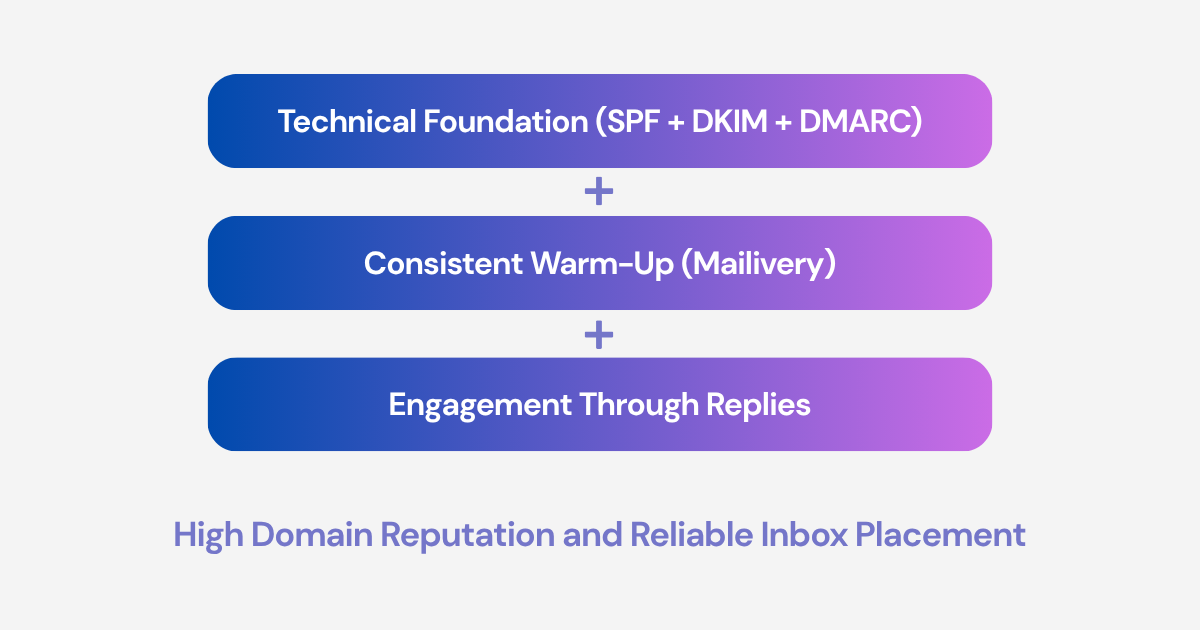.png)
Think of deliverability as a feedback loop. You send messages, recipients react, and mailbox systems adjust based on those reactions.
Your domain setup, authentication, and warm-up tell inbox providers who you are. Engagement tells them whether to keep trusting you.
Replies are the strongest confirmation that your emails belong in the inbox. They show filters that your messages lead to real interaction, not just automated outreach.
When that feedback stops (when recipients stop replying) your reputation starts to flatten, no matter how clean your infrastructure is.
Put simply: high reply rates build reputation, low reply rates erode it.
Open rates used to be the gold standard of engagement.
That changed when privacy updates from Apple and other mail clients made open tracking unreliable.
Now mailbox providers rely more on real engagement metrics and replies top that list.
Replies show mailbox algorithms that:
Even a short “Got it,” “Not interested,” or “Thanks” counts as a positive signal.
Mailbox providers do not analyze the tone of the reply; they only care that a human responded.
Related Reading: Improve Email Deliverability: The Complete 2025 Guide
This is why two companies using identical infrastructure can have drastically different deliverability outcomes.
Both are playing by the same technical rules, but only one is building domain trust through replies.
Mailbox providers like Gmail, Outlook, and Yahoo use machine learning to analyze behavioral data.
They observe what users do with emails and adjust filtering rules in real time.
When your emails generate replies, mailbox algorithms classify you as a trusted conversational sender.
When your messages are consistently ignored, deleted, or marked as spam, you’re reclassified as bulk or promotional.
Learn how to improve reply rates: 5 Reasons Your Cold Email Reply Rate Is Low - And How to Fix It
Here’s how it plays out over time:
So while open rate might help gauge copy performance, reply rate is what protects your domain reputation.
Here are proven tactics used by top-performing cold email teams (and Mailivery users) to boost replies while maintaining strong deliverability.
Examples:
Short, low-pressure questions lower the mental effort to reply.
Avoid:
Instead, aim for messages that sound handwritten: clear, curious, and to the point.
Best practice:
Smart follow-ups are about persistence, not pressure.
If you are getting replies, even negative ones, you’re doing something right.
Mailivery’s warm-up engine is designed around one principle: replies build reputation.
Every day, your mailboxes automatically exchange real, human-like messages with other inboxes.
Some messages get replies, others get opened or marked as read.
This consistent engagement teaches Gmail, Outlook, and Yahoo that your domain is trustworthy.
By the time you begin sending cold emails, your mailboxes already have a strong baseline of reputation built on authentic interactions.
The warm-up continues running in the background even after your outreach starts.
That ongoing pattern of replies and engagement helps maintain trust and recover quickly from any dips in deliverability.
Also read: What Is Email Warm-Up: The Missing Step in Email Deliverability
Example:
Two identical domains start cold outreach.
The one with Mailivery warm-up already running sees higher inbox placement and reply rates.
The one without warm-up sees throttling and delayed delivery from day one.
Warm-up is not a one-time setup, it’s a continuous reputation-building process.
Deliverability is not just about technical setup.
It’s about consistent engagement that trains mailbox providers to see you as trustworthy.
Here’s the simple formula:

Every email you send is an opportunity to build (or hurt) your sender reputation.
Focus on creating conversations, not campaigns because the inbox rewards engagement, not volume.
